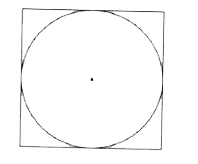A square is inscribed in a quarter circle in such a way that two of its adjacent vertices on the radius are equidistant from the centre and other two vertices lie on the circumference. If the side of square is √52 cm, then what is the radius (in cm) of the circle?
2
2.5
5
10
The correct Answer is:B
To solve the problem of finding the radius of the quarter circle in which a square is inscribed, we can follow these steps:
1. Understanding the Configuration:
- We have a quarter circle with a square inscribed in it.
- Let the center of the quarter circle be point O.
- Let the side length of the square be s=√52 cm.
- The square has two vertices (let's call them A and D) on the radii of the quarter circle, and the other two vertices (B and C) on the arc of the quarter circle.
2. Identifying the Triangle:
- Consider triangle OAD, where O is the center, A and D are the vertices of the square on the radii.
- Since A and D are equidistant from O, we can denote the distance from O to A (or D) as OA=OD=x.
3. Applying the Pythagorean Theorem:
- In triangle OAD, we have:
AD2=OA2+OD2
- Since AD=s=√52:
(√52)2=x2+x2
52=2x2
- Solving for x2:
x2=54
- Taking the square root:
x=√54=√52 cm
4. Finding the Length of BD:
- Now, consider triangle ABD, where AB = AD = s.
- By the Pythagorean theorem:
BD2=AB2+AD2
- Substituting AB=AD=√52:
BD2=(√52)2+(√52)2
BD2=52+52=5
- Thus:
BD=√5 cm
5. Finding the Radius:
- Now, consider triangle OBD:
OB2=OD2+BD2
- Substituting OD=x=√52 and BD=√5:
OB2=(√52)2+(√5)2
OB2=54+5=54+204=254
- Thus:
OB=√254=52 cm=2.5 cm
Final Answer
The radius of the quarter circle is 2.5 cm.
- We have a quarter circle with a square inscribed in it.
- Let the center of the quarter circle be point O.
- Let the side length of the square be s=√52 cm.
- The square has two vertices (let's call them A and D) on the radii of the quarter circle, and the other two vertices (B and C) on the arc of the quarter circle.
- Consider triangle OAD, where O is the center, A and D are the vertices of the square on the radii.
- Since A and D are equidistant from O, we can denote the distance from O to A (or D) as OA=OD=x.
- In triangle OAD, we have:
AD2=OA2+OD2
- Since AD=s=√52:
(√52)2=x2+x2
52=2x2
- Solving for x2:
x2=54
- Taking the square root:
x=√54=√52 cm
- Now, consider triangle ABD, where AB = AD = s.
- By the Pythagorean theorem:
BD2=AB2+AD2
- Substituting AB=AD=√52:
BD2=(√52)2+(√52)2
BD2=52+52=5
- Thus:
BD=√5 cm
- Now, consider triangle OBD:
OB2=OD2+BD2
- Substituting OD=x=√52 and BD=√5:
OB2=(√52)2+(√5)2
OB2=54+5=54+204=254
- Thus:
OB=√254=52 cm=2.5 cm
The radius of the quarter circle is 2.5 cm.
Topper's Solved these Questions
- GEOMETRYBOOK - KIRAN PUBLICATIONCHAPTER - GEOMETRYEXERCISE - TRY YOURSELF
25 Videos
- GEOMETRYBOOK - KIRAN PUBLICATIONCHAPTER - GEOMETRYEXERCISE - QUESTIONS ASKED IN PREVIOUS SSC EXAMS (TYPE- XIII)
70 Videos
- DISCOUNTBOOK - KIRAN PUBLICATIONCHAPTER - DISCOUNTEXERCISE - Test Yourself
10 Videos
- LCM AND HCF BOOK - KIRAN PUBLICATIONCHAPTER - LCM AND HCF EXERCISE - Test Yourself
18 Videos
Similar Questions
Knowledge Check
A square is inscribed in a quarter circle in such a manner that two of its adjacent vertices lie on two radli and are equidistant from the centre. The other two vertices lie on the circular arc. If the length of the side of the square is 20 cm, find the radius of the circle. (in cm.)
A10√10B20√10C10√20D10√30A square is inscribed in a quarter-circle in such a manner that two of its adjacent vertices lie on the two radil at an equal distance from the centre, while the other two vertices lie on the circular arc. If the square has sides of length x, then the radius of the circle is
A√2xB16xπ+4C2x√πD√5x√2A square is inscribed in a quarter-circle in such a manner that two of its adjacent vertices lie on the two radii at an equal distance from the centre, while the other two vertices lie on the circular arc. If the square has sides of length x, then the radius of the circle is
A√2xB16xπ+4C2x√πDsqr(5)x√2
If the side of the square is 21 cm then the circumference of the circle in the figure is

View SolutionIf two equal circles are such that the centre of one lies on e circumference of the other, then the ratio of the common chord of two circles to the radius of any of the circles is :
View SolutionIf the side of a square is 24 cm, then the circumference of its circumscribed circle ( in cm ) is :
View SolutionThe circumference of a circle is equal to the perimeter of a square. If the length of the diagonal of the square is 11√2cm, then what is the area of the circle ?
View SolutionIf two equal circles are such that the centre of one lies on e circumference of the other, then the ratio of the common chord of two circles to the radius of any of the circles is :
View Solution

